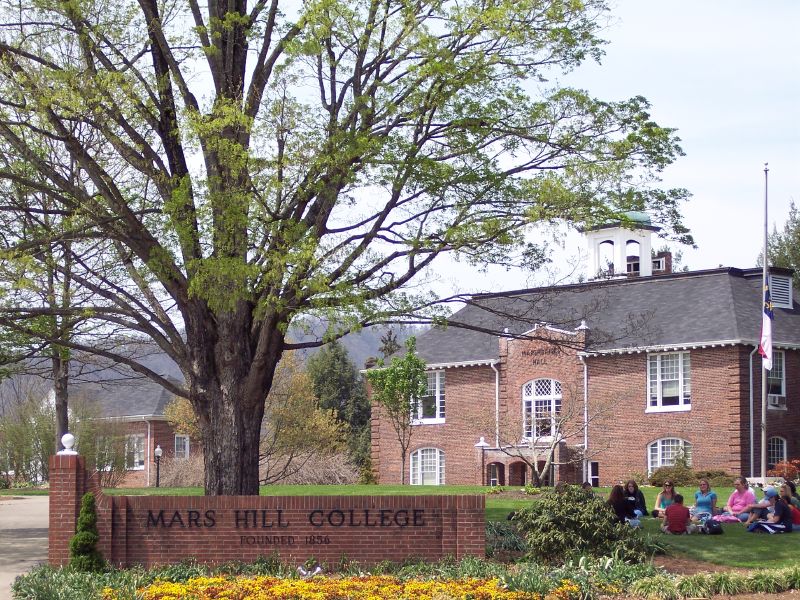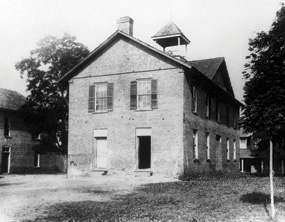Mars Hill University
 Mars Hill College, a Baptist institution located 18 miles north of Asheville, traces its origins to the French Broad Baptist Academy, which opened its doors in 1856 on land donated by Edward Carter. According to contemporary accounts, an enslaved person named Joe Anderson was employed as collateral by the academy's contractor until the contractor was remunerated for his work. Among other early benefactors of the academy were J. W. Anderson (Joe Anderson's owner), T. S. Deaver, Berry Duyck, William Keith, Thomas Ray, and J. C. Sams. In 1859 the North Carolina General Assembly granted the academy the name suggested by trustee Lewis Palmer, Mars Hill College, from the Bible's Acts 17:22: "Then Paul stood in the midst of Mars Hill."
Mars Hill College, a Baptist institution located 18 miles north of Asheville, traces its origins to the French Broad Baptist Academy, which opened its doors in 1856 on land donated by Edward Carter. According to contemporary accounts, an enslaved person named Joe Anderson was employed as collateral by the academy's contractor until the contractor was remunerated for his work. Among other early benefactors of the academy were J. W. Anderson (Joe Anderson's owner), T. S. Deaver, Berry Duyck, William Keith, Thomas Ray, and J. C. Sams. In 1859 the North Carolina General Assembly granted the academy the name suggested by trustee Lewis Palmer, Mars Hill College, from the Bible's Acts 17:22: "Then Paul stood in the midst of Mars Hill."
During the Civil War, which split the region around Mars Hill along Unionist and Confederate lines both during and after the conflict, the school was closed for two years (1863-65). Fourteen school presidents served between 1865 and 1897, reflecting the instability of the institution. From 1872 to 1878 the college was closed; its building functioned as a branch of the Oxford Masonic Orphanage under John Robert Sams and J. H. Moore from 1872 to 1876 and as a "subscription school" under James Bassett Lunsford from 1876 to 1878.
 Mars Hill College reopened in 1878 but continued to struggle throughout the remainder of the nineteenth century. It was the accession of Wake Forest alumnus Robert Lee Moore as president of the college in 1897 that precipitated an era of growth. In 1921 Mars Hill obtained junior college status, and in 1937 its high school division was eliminated. Moore retired in 1938 and was succeeded by South Carolinian Hoyt Blackwell, a Latin and Greek professor. During Blackwell's tenure, Mars Hill achieved four-year status and awarded its first baccalaureate degrees in 1964. The college began admitting African American students in 1961; notably, the first black student to enroll was Oralene Graves, the great-great-granddaughter of Joe Anderson.
Mars Hill College reopened in 1878 but continued to struggle throughout the remainder of the nineteenth century. It was the accession of Wake Forest alumnus Robert Lee Moore as president of the college in 1897 that precipitated an era of growth. In 1921 Mars Hill obtained junior college status, and in 1937 its high school division was eliminated. Moore retired in 1938 and was succeeded by South Carolinian Hoyt Blackwell, a Latin and Greek professor. During Blackwell's tenure, Mars Hill achieved four-year status and awarded its first baccalaureate degrees in 1964. The college began admitting African American students in 1961; notably, the first black student to enroll was Oralene Graves, the great-great-granddaughter of Joe Anderson.
The modern Mars Hill College occupies over 200 acres of land with 32 buildings. In the early 2000s it enrolled nearly 1,000 students and offered bachelor's degrees in 30 majors.
In August 15, 2013, Mars Hill College officially changed its name to Mars Hill University.
References:
Edward Jennings Carter, "A History of Mars Hill College" (M.A. thesis, UNC-Chapel Hill, 1940).
Clarence Dixon Creasman, Moore of Mars Hill (1950).
John Angus McLeod, From These Stones: Mars Hill College, 1856-1968 (1968).
Additional Resources:
Mars Hill College: #
Mars Hill College, NC Highway Historical Marker P-34: https://www.ncdcr.gov/about/history/division-historical-resources/nc-highway-historical-marker-program/Markers.aspx?sp=search&k=Markers&sv=P-34
Mars Hill University Yearbooks: https://lib.digitalnc.org/search?ln=en&p=691:%22Mars+Hill+University%22%20AND%20655:%22Yearbooks%22&sf=year&so=a
Mars Hill, Madison County: http://www.visitmadisoncounty.com/activities/self-guided-tours/mars-hill-historic-markers/
Mars Hill, North Carolina Humanities Council: http://nchumanities.org/content/mars-hill
History of Mars Hill College: #about-mhc/history-of-the-college
Image Credit:
LearnNC. 2007. "Mars Hill College in Mars Hill, North Carolina." Online at http://www.learnnc.org/lp/multimedia/7792. Accessed 11/1/2012.
"The First Campus Building (1856-1910)." Image courtesy of Mars Hill University. Available from http://www.mhu.edu/about-mhu/history-of-the-university (accessed May 7, 2014).
1 January 2006 | Martin, James I., Sr.